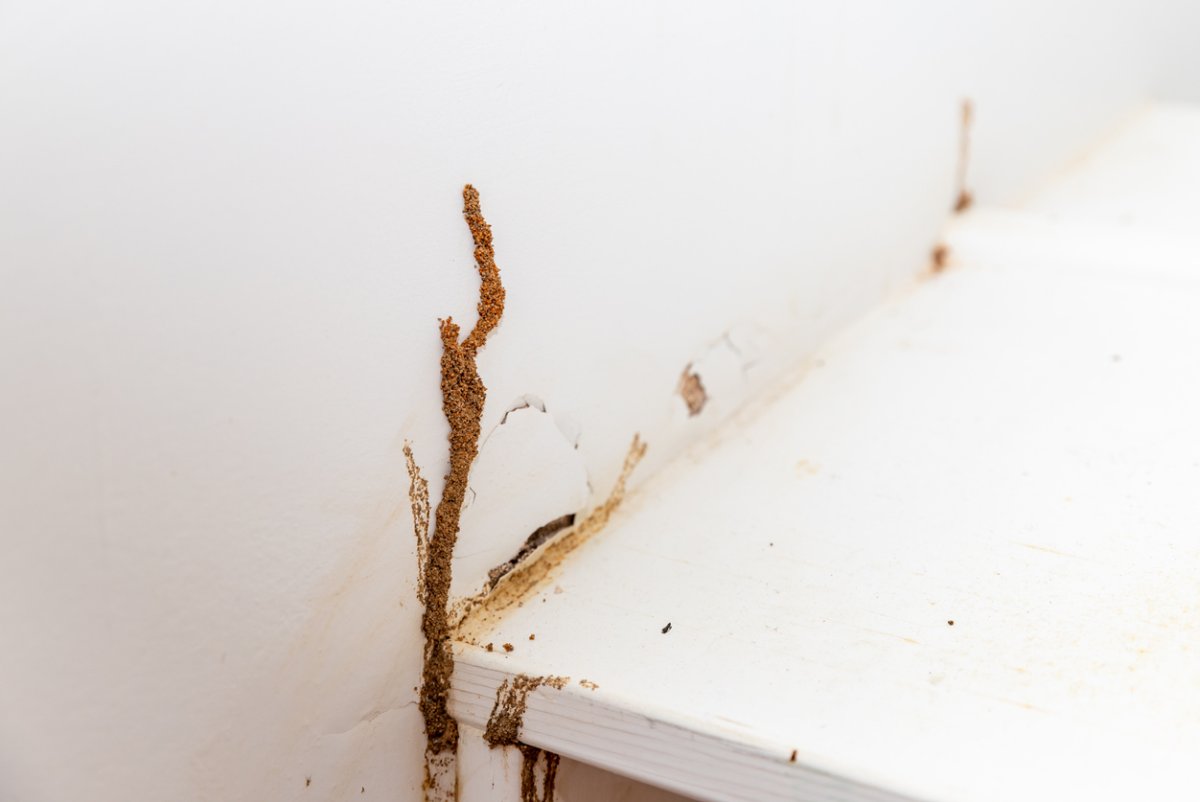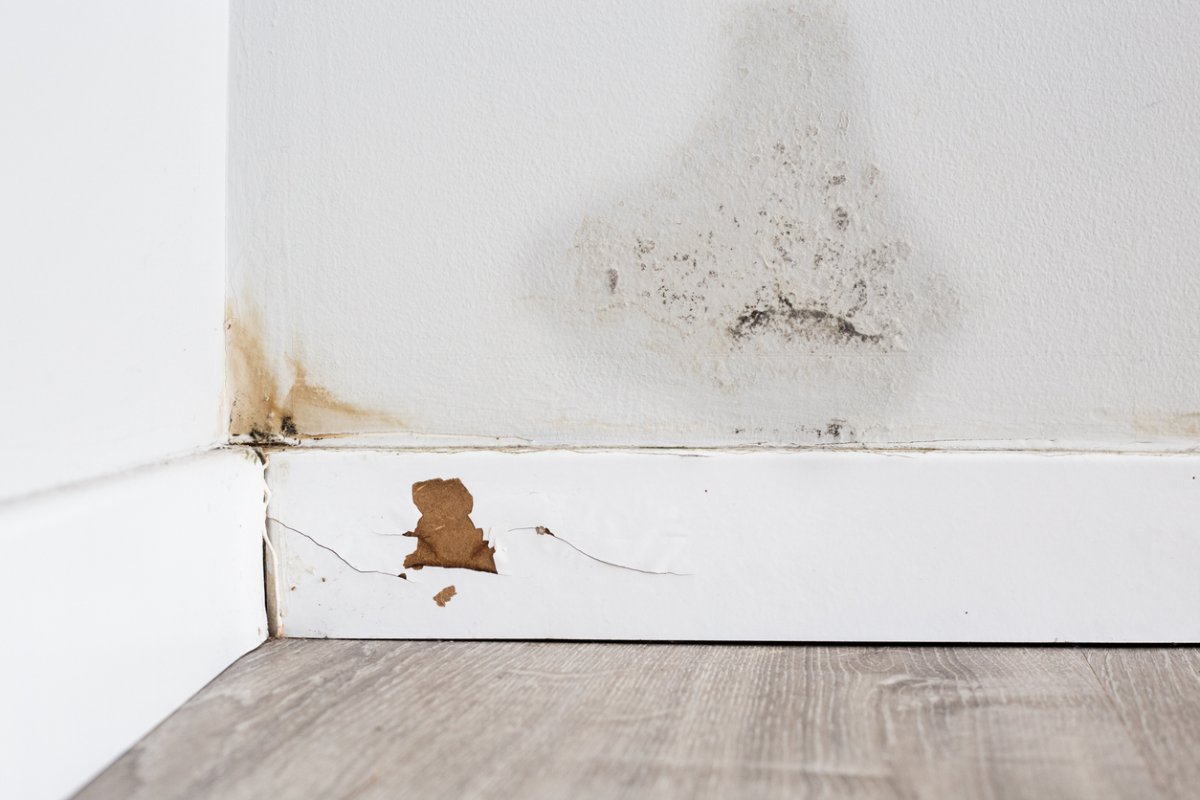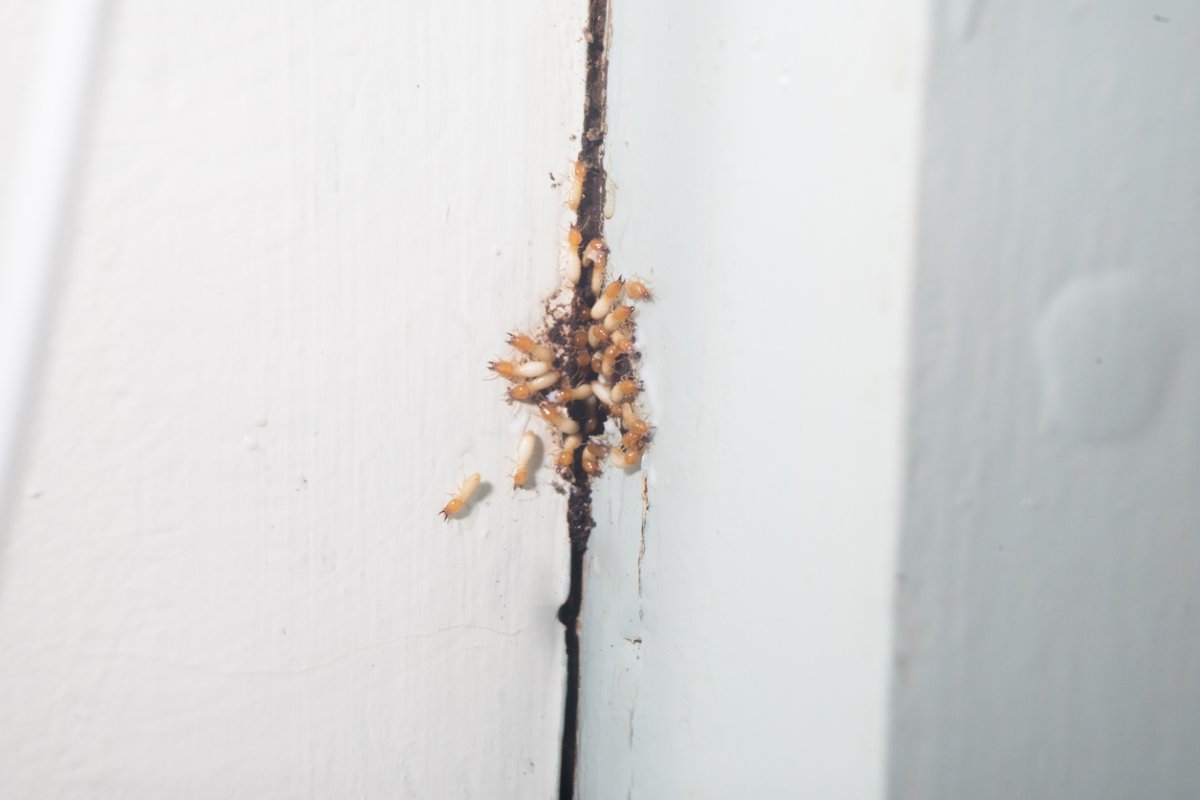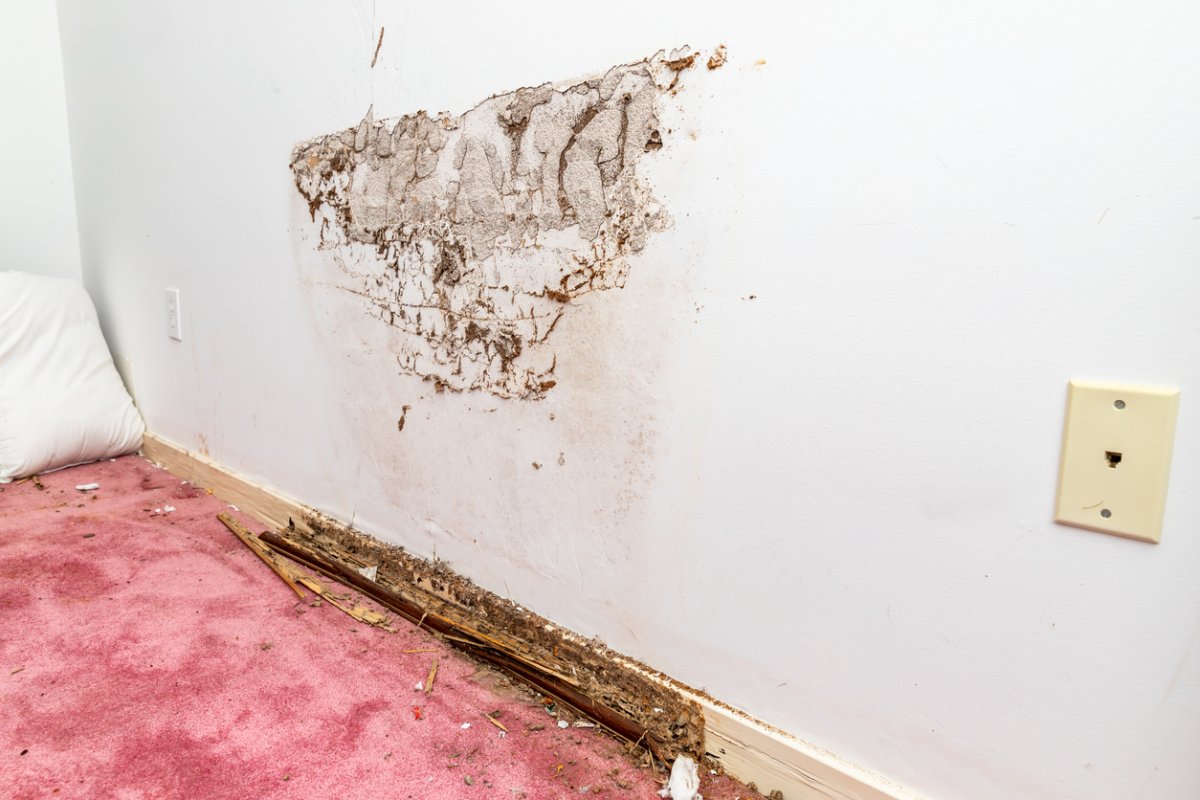We may earn revenue from the products available on this page and participate in affiliate programs. Learn More ›
What You Need to Know
- Water damage and termite damage can look similar, as both may result in bubbling or peeling paint.
- Termite damage may look different depending on whether it was created by dampwood, drywood, or subterranean termites.
- Water damage is characterized by a square-shaped “cell” pattern, staining, a spongy feel, and fungus. Termite damage can be identified by small pin-shaped holes in the wood, a hollow sound, mud tunnels, and the presence of termite droppings, also called “frass.”
- Some kinds of termites are attracted to water-damaged wood, so it is possible to have both problems simultaneously.
- Both water damage and termite damage can negatively impact the structural integrity of a home and will need to be addressed by the appropriate professionals.
Most homeowners are able to recognize when something is amiss with the materials in their home. Discoloration on walls, bubbling paint, and cracking or warping wood are all signs of an underlying issue. Termite damage and water damage are two common culprits, but homeowners who have not dealt with either problem before may find it difficult to distinguish between these two issues.
Unfortunately, neither termite damage nor water damage is good news. The longer these problems go unaddressed, the more severe the damage will ultimately become, and the more costly it will be to repair. Each type of damage is likely to require intervention from a professional, whether that’s one of the best termite control companies (such as Terminix or Ehrlich) or the best water damage restoration services (like ServiceMaster Restore or ServPro). Learning a few ways to identify the root cause of your home’s damage is the first step in returning it to a safe and healthy state.

An Important Note About Termite Damage
Water damage has a fairly consistent appearance: cube-shaped cells, yellow or brown staining, and bubbling or peeling paint are some of its hallmarks. The appearance of termite damage, however, can be surprisingly different depending on the species of termite that created it. The three main types of termites in the U.S. are dampwood, drywood, and subterranean termites.
- Dampwood termites are common in the southwestern United States, with some varieties spreading into states such as Oregon, Washington, Nevada, Montana, and Idaho. In the wild, these termites inhabit and feed on wet, rotting wood such as dead trees. They are less likely than other varieties to be found in homes unless the home has water damage. If they do make it into a home, they create holes in wood, making the material hollow and spongy.
- Drywood termites are found all across the southern United States from South Carolina to California. Unlike dampwood termites, they need very little moisture and can inhabit solid, dry wood. Once a colony is established, they create complex networks of tunnels punctuated by small holes for entering and exiting, which may be accompanied by small piles of sawdust-like droppings, called frass. Drywood termite-damaged wood has a smooth appearance and can be found on the interior or exterior parts of a home.
- Subterranean termites are widely considered to be the most destructive termite variety in the U.S. Found in every state except Alaska, subterranean termites create large nests in the soil. They are the only variety to create mud tubes, which they use to travel to the wood structures they feed on. These mud tubes are most commonly found on the exterior walls and siding of a home. Wood damaged by subterranean termites will have tunnels that follow the grain of the wood and are lined with mud.
Similarities Between Termite Damage and Water Damage
At first glance, both water damage and termite wood damage cause paint to peel and bubble away from surfaces. Some termites also seek out areas with high moisture levels. For this reason, it’s not uncommon for homeowners to assume that damage to damp parts of the home is the result of water infiltration when it has actually been caused by termites. Water damage can also attract termites, so it is possible to have both water damage and termite damage in the same space. Fortunately, there are many differences between termite damage and water damage that make it easy to differentiate between them upon closer inspection.

Differences Between Termite Damage and Water Damage
Looking out for some key characteristics can help most people distinguish termite damage from water damage.
1. Water-damaged materials develop a distinct square-shaped “cell” pattern, but termites create small, round holes.
Wood is a porous material, so when it is exposed to water, the moisture will cause the material to swell. This causes the surface of the wood to crack in a square pattern that is sometimes referred to as “alligatoring” since it resembles the texture of an alligator’s back. This phenomenon is unique to water damage. Termites, on the other hand, may create small holes on the surface of the wood, which they use to enter and exit their tunnels. These holes are about the size of a pin. One way to confirm that these tiny holes are indeed a sign of termites is to look for nearby piles of “frass,” which are termite droppings that look like sawdust.
2. Wood that is harboring termites will sound hollow, whereas water-damaged wood has a spongy feel.
One of termites’ classic behaviors is creating tunnels in wood to form galleries. The more tunnels created, the more the structural integrity of the wood is compromised. Walls that sound hollow when knocked on are a clear indication of termites that have been at work inside for some time. Severe termite wood damage can result in wood needing to be replaced once the colony has been removed.
Water damage has a different effect on wooden materials. Rather than feeling hard and hollow, water-damaged wood feels soft and spongy to the touch. This is an especially noticeable sign of water damage under the floor. A wood floor with water damage may also begin to crumble when it is disturbed. It’s worth noting that wood that is housing dampwood termites may also be damp or spongy, as these termites prefer water-damaged materials.

3. Some types of termites create mud tunnels on the surface of walls. Water-damaged surfaces may develop fungus or mold.
At a glance, walls inhabited by subterranean termites may appear to have a kind of growth that runs in trails along their surface. These are actually mud tunnels, or mud tubes. These tunnels have a vein-like structure and are composed of dirt, frass, and wood fragments. Subterranean termites live underground, and they use mud tunnels as a means of traveling from their nests in the soil to the wood they are feasting on. Mud tubes are a telltale sign that you need to begin termite treatment.
Water-damaged wood may have a different type of textured substance on its surface, as water damage and mold go hand in hand. Mold or fungus has a fuzzy appearance and can develop in a variety of colors from white to green to black. Unlike mud tubes, which are formed in lines, mold typically grows in a circular pattern. If the mold is growing out of sight, you may notice the smell of mold first, as it has a strong musty odor.
4. Sections of wood affected by water damage typically darken, but termite damage results in little to no discoloration.
Anyone who has ever discovered a roof leak by noticing water stains on the ceiling knows that water damage creates unsightly discoloration on the materials it affects. On the drywall of water- damaged walls, this typically comes in the form of a yellowish-brown stain. On wood, the surface may darken and warp.
Termite damage does not cause discoloration, so unless the wall has also developed water damage, it will remain the same color throughout the termite infestation. However, termite damage can make the wood surface look wavy, similar to the way that water damage causes warping.
5. Water damage and termite damage may occur simultaneously as some termites are attracted to moist and rotting wood.
Termite damage and water damage are not mutually exclusive. In fact, moisture and dampness can attract dampwood and subterranean termites as they need these kinds of environments to survive. Dampwood termites in particular will only feed on wood that has begun to rot from water infiltration. In the event that a home has both kinds of damage, signs of termites and water damage will both be present. Wood rot can set in in as little as a week after water damage, and it doesn’t take long for termites to follow. If you know you had recent water damage but are not sure if termites have yet infiltrated, a good test is to tap the wood with your finger or a hammer and listen to the sound it makes. If it sounds hollow, there is likely a termite colony inside. If not, it’s worth getting the water damage repaired quickly before termites begin to move in.
Which Professional to Call for Termite Damage or Water Damage
Depending on the issue, homeowners will have different needs and therefore will need to contact different types of professionals.
If you have termites, contact a pest control technician to facilitate removal and prevention measures.
Most homeowners don’t dream of having either termite or water damage in their home. However, they may not understand the amount of damage either of these issues can cause.
Termites can go undetected for years, and in that time can significantly affect the structural soundness of the home. In a worst-case scenario, water-damaged ceilings or floors may even collapse. Exterminator costs can be high, and it may be tempting to postpone the hassle of scheduling an appointment with a professional. However, homeowners will want to get in touch with one of the best pest control companies that treats termites at the first sign of trouble. This will save them the additional time, money, and stress of a more advanced problem in the future.
Professionals who restore water damage can prevent the problem from turning into a mold infestation.
Water damage may be even more insidious than termites—in addition to structural damage, it also has the potential to lead to mold growth. Water damage mold is a major health hazard that can cause allergy-like symptoms such as sneezing, coughing, and itchy eyes at best. At worst, those with underlying health issues such as asthma may experience difficulty breathing or more frequent asthma attacks. To ensure the home is once again safe to inhabit, a water damage restoration company will ensure the home is once again safe to inhabit by fixing water damage and replacing any affected materials. Mold can develop in as little as 24 hours, so many companies also have emergency water damage services available.
Those who are unfortunate enough to have both water damage and termite damage will have both water damage restoration costs and termite treatment costs to contend with. However, these costs are well worth the peace of mind and security that comes with having a pest- and mold-free home.


